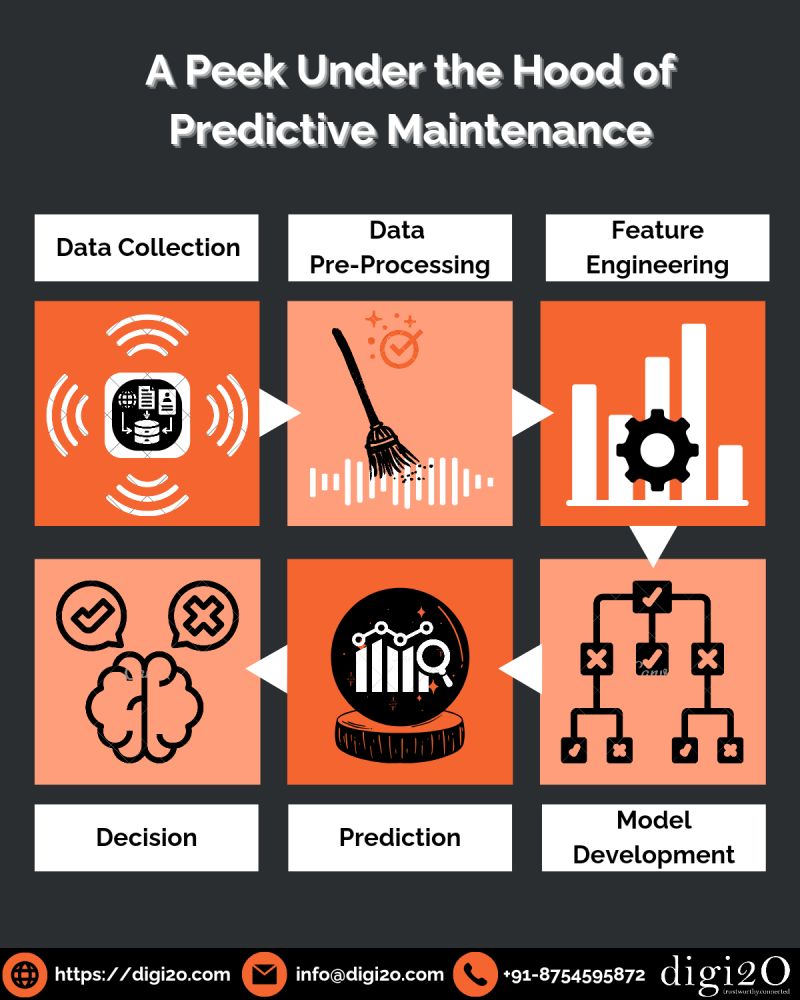
Ever wondered how AI can predict when machinery will fail??
Here, we are excited to take you on a journey into the heart of AI-driven predictive maintenance, revealing how it transforms raw data into invaluable predictions for machinery breakdowns?
Data Collection and Preprocessing?
It all starts with data, lots of it. In the realm of predictive maintenance, data is king. Sensors, IoT devices, and other data sources continuously capture a treasure trove of information, including temperature, vibration, pressure, and operational parameters from machinery. But this raw data isn't immediately ready for AI wizardry. It undergoes a meticulous process known as data preprocessing.
Cleaning the Data: Imagine this data as a river of information. But in this river, there are stones and debris noise and anomalies that can lead to incorrect predictions. To ensure that the algorithms operate on accurate and reliable information, we meticulously clean the data. This is like removing the pebbles from the river to make it flow smoothly.
Feature Engineering?
Now that we have our pristine data, the next step is feature engineering. This is where we craft the building blocks that AI will use to make predictions.
Selecting Relevant Attributes: Think of feature engineering as selecting the right ingredients for a recipe. We have domain experts who understand the machinery inside out, and they identify which aspects of the data are most indicative of machinery health. These attributes are then carefully chosen to feed into the predictive algorithms.
Algorithm Selection✅
With our data prepared and our features selected, it's time to choose the right algorithm. The choice of algorithm depends on the nature of the problem at hand. In the world of predictive maintenance, we have a toolbox of powerful options.
Machine Learning Techniques: These include Random Forests, Support Vector Machines, or deep learning methods like recurrent neural networks (RNNs) and Long ShortTerm Memory (LSTM) networks for timeseries data. It's like selecting the best tool for the job, and our experts are wellversed in making that choice.
Model Training?
Now comes the training phase. Our algorithms are like eager students in a classroom, ready to learn from historical data. They want to understand the relationships between features and the occurrence of machinery breakdowns.
Learning from Historical Data: During this phase, the algorithms adjust their internal parameters to minimize prediction errors. It's like refining their skills over time. They learn to recognize complex patterns and correlations in the data. Large datasets, often collected over an extended period, are crucial for training accurate models. It's like gaining wisdom through experience.
RealTime Monitoring?️
Once our predictive models are trained, they become vigilant sentinels integrated into the production environment. They continuously monitor machinery in realtime, 24/7.
Constant Vigilance: These algorithms are like tireless guards, comparing incoming data with the patterns they've learned. Any deviations, even the slightest blip, trigger alerts of potential breakdowns. It's akin to having a team of experts on watch around the clock.
Predictive Insights?
Predictive maintenance doesn't stop at issuing warnings about imminent failures. It provides invaluable insights into the probability and severity of potential issues.
Prioritizing Actions: By analyzing the output of the algorithms, maintenance teams can prioritize actions. It's like having a crystal ball that not only predicts the future but also suggests what actions to take. Whether it's scheduling maintenance during planned downtime or replacing a critical component, these insights are gold for businesses.
In a nutshell, the inner workings of predictive algorithms are a symphony of data collection, preprocessing, feature engineering, machine learning, and realtime monitoring. It's a complex orchestration of technology and expertise, all aimed at ensuring machinery breakdowns become a thing of the past, maximizing productivity in the era of Industry 4.0✨
Key Takeaways?
Data is the Foundation: Without quality data, predictive maintenance wouldn't be possible. It all starts with thorough data collection and cleaning.
Feature Engineering Matters: Selecting the right attributes to feed into the algorithms is crucial. It's like choosing the right ingredients for a recipe.
Algorithm Selection is Strategic: Different problems require different algorithms. The choice of algorithm is like picking the right tool for the job.
Continuous Learning: Algorithms continuously learn from historical data, improving their predictive accuracy over time.
RealTime Monitoring: Predictive models become real-time guardians, alerting teams to potential issues as they happen.
Actionable Insights: Predictive maintenance doesn't just predict; it guides actions, helping businesses save time and resources.
Designed by W3Squad